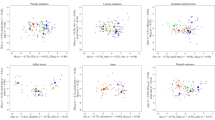Abstract
This study examined whether two paralinguistic variables, vocal loudness and response latency, were associated with confidence in answers to trivia questions. Audience presence and size were manipulated and subjects' assertiveness was measured. Subjects verbally responded to trivia questions by indicating their choice and how confident they were in each answer. Tapes of these responses were later analyzed for latency of response and loudness of speech. As expected, the more confident individuals were in their answers, the faster and louder they responded. Assertive subjects spoke louder. The presence of an audience had no effects on vocal responding. Apparently, the confidence of a speaker can be inferred from the speed and loudness of the speaker's responses.
Similar content being viewed by others
References
Apple, W., Streeter, L. A., & Krauss, R. B. (1979). Effects of pitch and speech rate on personal attributions.Journal of Personality and Social Psychology, 37, 715–727.
Bond, C. E., & Titus, L. J. (1983). Social facilitation: A meta-analysis of 241 studies.Psychological Bulletin, 94, 265–292.
Cook, M. (1969). Anxiety, speech disturbance, and speech rate.British Journal of Social and Clinical Psychology, 8, 13–21.
DePaulo, B. M., Stone, J. I., & Lassiter, D. G. (1985). Telling ingratiating lies: Effects of target sex and target attractiveness on verbal and nonverbal deceptive success.Journal of Personality and Social Psychology, 48, 1191–1203.
Ekman, P., Davidson, R. J., & Friesen, W. V. (1990). The Duchenne smile: Emotional expression and brain physiology II.Journal of Personality and Social Psychology, 58, 342–353.
Ekman, P., & Friesen, W. V. (1969). Nonverbal leakage and cues to deception.Psychiatry, 32, 88–108.
Erickson, B., Lind, E. A., Johnson, B. C., & O'Barr, W. M. (1978). Speech style and impression formation in a court setting: The effects of “powerful” and “powerless” speech.Journal of Experimental Social Psychology, 14, 266–279.
Exline, R. V., Ellyson, S. L., & Long, B. D. (1975). Visual behavior as an aspect of power role relationships. In P. Pliner, L. Krames, & T. Alloway (Eds.),Advances in the study of communication and affect (Vol. 2). New York: Plenum.
Hemsley, G. D., & Doob, A. N. (1978). The effect of looking behavior on perceptions of a communicator's credibility.Journal of Applied Social Psychology, 8, 135–144.
Kimble, C. E., & Musgrove, J. I. (1988). Dominance in arguing, mixed-sex dyads: Visual dominance patterns, talking time, and speech loudness.Journal of Research in Personality, 22, 1–16.
Latane, B. (1981). The psychology of social impact.American Psychologist, 36, 343–356.
LeCompte, W. A. (1981). The ecology of anxiety: Situational stress and rate of self-stimulation in Turkey.Journal of Personality and Social Psychology, 40, 712–721.
MacLachlan, J., Czepiel, J., & LaBarbera, P. (1979). Implementation of response latency measures.Journal of Marketing Research, 16, 573–577.
Miller, N., Maruyama, G., Beaber, R. J., & Vallone, K. (1976). Speed of speech and persuasion.Journal of Personality and Social Psychology, 34, 615–624.
Rathus, S. (1973). A 30-item schedule for assessing assertive behavior.Behavior Therapy, 4, 398–406.
Scherer, K. R., London, H., & Wolf, J. J. (1973). The voice of confidence: Paralinguistic cues and audience evaluation.Journal of Research in Personality, 7, 31–44.
Streeter, L. A., Krauss, R. M., Geller, V., Olson, C., & Apple, W. (1977). Pitch changes during attempted deception.Journal of Personality and Social Psychology, 35, 345–350.
Zajonc, R. B. (1965). Social facilitation.Science, 149, 269–274.
Author information
Authors and Affiliations
Additional information
This study was a Master's thesis project conducted by the second author under the supervision of the first author.
Rights and permissions
About this article
Cite this article
Kimble, C.E., Seidel, S.D. Vocal signs of confidence. J Nonverbal Behav 15, 99–105 (1991). https://doi.org/10.1007/BF00998265
Issue Date:
DOI: https://doi.org/10.1007/BF00998265




